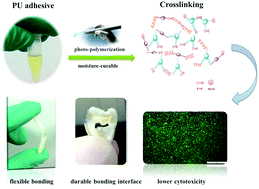Photopolymerizable and moisture-curable polyurethanes for dental adhesive applications to increase restoration durability†
Abstract
In this study we evaluated dual-cure polyurethanes (PUs) as dental adhesives and investigated their effect on the durability of the resin–dentin bonding interface. Different novel photopolymerizable and moisture-curable PUs based on polyester polyol, polyether polyol, and hydroxyethyl methacrylates (HEMAs) were prepared, and their structural characteristics were evaluated by Fourier transform infrared spectroscopy. The tensile strength, elongation at break, and water sorption/solubility of the PU adhesives and the application for bonding with dentin were evaluated. The water sorption and solubility of the PU adhesives were significantly lower than those of two commercial control groups. The bond strength of the PU adhesives after 30 days of storage increased compared with their immediate bond strength, and the microleakage detection of Class V restorations showed less occurrence of marginal leakage compared with the commercial control groups. Cytotoxicity testing has shown that the PU adhesives have low toxicity to pulp cells. The results of this study may shift the future research focus of composite resin dental restoratives from original rigid bonding of the interface to a flexible bonding based on the use of PU adhesives. This may become a new strategy for decreasing the occurrence of microleakage and improving the durability of the bonding interface.



 Please wait while we load your content...
Please wait while we load your content...